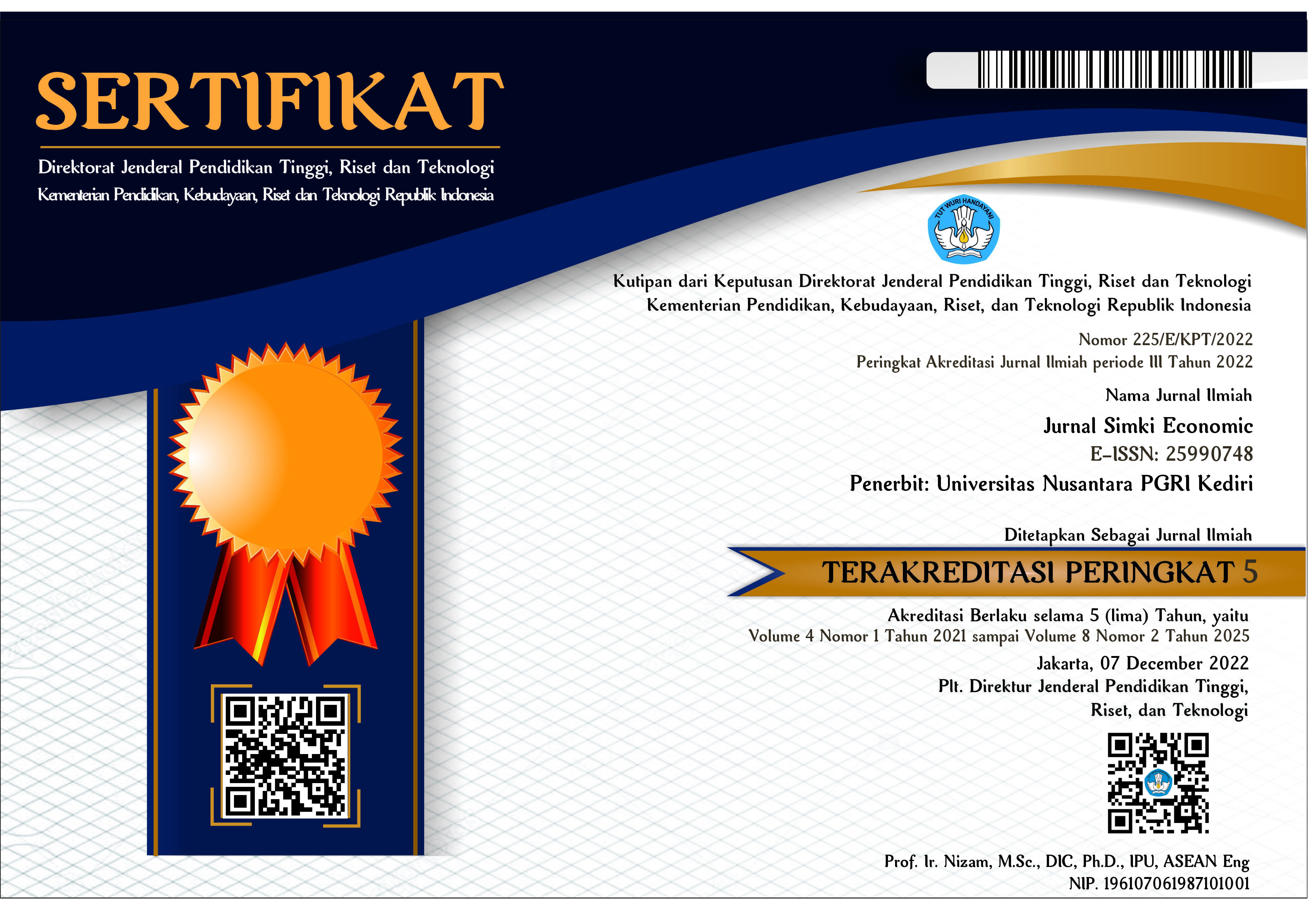Analisis Pengembalian Portofolio Investasi Perusahaan Asuransi Wajib di Indonesia Studi pada PT. Jasa Raharja (Persero) Tbk Periode 2013-2022
 Abstract views: 347
,
Abstract views: 347
,
 PDF (Bahasa Indonesia) downloads: 308
PDF (Bahasa Indonesia) downloads: 308
Abstract
This study aims to determine the level of return on investment in the investment portfolio of PT. Jasa Raharja for the period 2013 to 2022. This research method uses a quantitative method involving the process of collecting secondary data for ten years, then conducting a financial ratio analysis followed by multiple regression analysis, then describing the interpretation of the research results. The results of the financial ratio analysis using the net investment income ratio showed that in each period the level of return on the investment portfolio tended to continue to decline from 10% in 2013 to 6.89% in 2022. The results of the normality test to test the sample obtained a normally distributed sample, then the results of the multiple regression test showed that the results of the investment portfolio and the value of the investment portfolio together affected the net investment income ratio. In this study, the company was less than optimal in managing its investment funds. Therefore, the company is less able to rely on the investment returns obtained to add new investment funds in the next period. If this happens continuously, the company in meeting funds for payment of claim expenses and other company operational expenses can only rely on premium income from customers so that the company's profits are low.
Downloads
References
Agustina, N., & Rachman, R. (2023). An Alternative Measurement of The Rate of Return on Investment Portfolio in Insurance Company. Proceeding of The 6th International Seminar on Business, Economics, Social Science, and Technology (ISBEST), 3(1), 20–24. https://doi.org/10.33830/isbest.v3i1.1221
Creswell, J. W., & Creswell, J. D. (2018). Research Design: Qualitative, Quantitative, and Mixed Methods Approaches (5th ed.). SAGE Publications.
Dunia, F. A. (2013). Pengantar Akuntansi. Lembaga Penerbit FEUI.
Fabozzi, F. J., & Markowitz, H. M. (2011). Overview of Investment Management. In F. J. M. H. M. Fabozzi (Ed.), The Theory and Practice of Investment Management (2nd ed., pp. 3–14). John Wiley & Sons.
Fatimatuzzahra, F., & Sukmaningrum, P. S. (2018). Kinerja Keuangan pada Perusahaan Asuransi Umum Syariah dan Asuransi Jiwa Syariah di Indonesia Periode 2014-2016. Jurnal Ekonomi Syariah Teori Dan Terapan, 5(7), 606–622. https://doi.org/10.20473/vol5iss20187pp606-622
Fitriyani, I., & Munandar, A. (2020). Analisis Biaya Modal Terhadap Tingkat Pengembalian Investasi Pada PT. Mitra Adiprakasa, Tbk. Moneter: Jurnal Akuntansi Dan Keuangan, 7(2), 192–197. https://doi.org/10.31294/moneter.v7i2.7966
Hartono, J. (2017). Teori Portofolio dan Analisis Investasi (11th ed.). BPFE.
Oktaviani, K., & Rahadian, D. (2014). Analisis Pengukuran Kinerja Investasi PT. Taspen (Persero) dengan Menggunakan Metode Economic Value Added. Jurnal Manajemen Maranatha, 13(2), 163–174. https://doi.org/10.28932/jmm.v13i2.133
Saunders, R. A. (1986). Life Insurance Company Financial Statements: Keys to Successful Reporting. Teach’em.
Sugiyono, & Susanto, A. (2015). Cara Mudah Belajar SPSS & Lisrel, teori dan aplikasi untuk analisis data penelitian. Alfabeta.
Sugiyono. (2022). Metode Penelitian Kuantitatif. Alfabeta.
Warto, & Khumaini, S. (2022). Analisis Hasil Investasi Dana Asuransi Jiwa Syariah di Indonesia Periode 2014-2021. Al Maal: Journal of Islamic Economics and Banking, 4(1), 68–88. https://dx.doi.org/10.31000/almaal.v4i1.6651
Copyright (c) 2024 Nurdiana Agustina, Dini Nurhayati, Santi Sartika

This work is licensed under a Creative Commons Attribution 4.0 International License.














